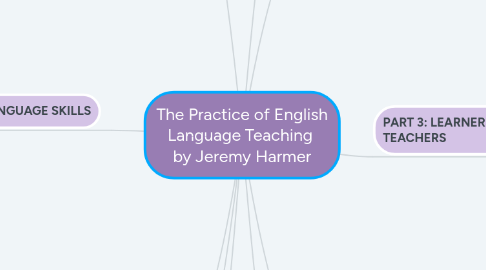
1. PART 1: LANGUAGE
1.1. CHAPTER 1: THE CHANGING WORLD OF ENGLISH
1.1.1. A language story
1.1.2. EFL, ESL, ESOL & ELF
1.2. CHAPTER 2: DESCRIBING THE ENGLISH LANGUAGE
1.2.1. Language in use
1.2.2. What we want to say
1.2.3. Language as text and discourse
1.2.4. Grammar
1.2.5. Lexis
1.2.6. The sounds of the language
1.2.7. Paralinguistic features of languages
1.2.8. Speaking and writing
2. PART 2: THEORIES, METHODS AND TECHNIQUES
2.1. CHAPTER 3: BACKGROUND ISSUES IN LANGUAGE LEARNING
2.1.1. The miracle of language
2.1.2. The importance of repetition
2.1.3. Thinking about language
2.1.4. Arousal, affect and humanistic teaching
2.1.5. When you're ready
2.1.6. Language play
2.2. CHAPTER 4: POPULAR METHODOLOGY
2.2.1. Approaches, methods, procedures and techniques
2.2.2. What methodology?
3. PART 3: LEARNERS AND TEACHERS
3.1. CHAPTER 5 : DESCRIBING LEARNERS
3.1.1. Age
3.1.2. Learner differences
3.1.3. Language levels
3.1.4. Motivation
3.2. CHAPTER 6 : DESCRIBING TEACHER
3.2.1. What is "teaching'?
3.2.2. In the classroom
3.2.3. Rapport
3.2.4. The teacher as teaching aid
3.2.5. Native speaker teachers and non-native-speaker teachers
3.3. CHAPTER 7 : DESCRIBING LEARNING CONTEXT
3.3.1. The place and means of instruction
3.3.2. Class size
3.3.3. Managing mixed ability
3.3.4. Monolingual, bilingual, and multilangual
4. PART 4 : MANAGING LEARNING
4.1. CHAPTER 8 : MISTAKES AND FEEDBACK
4.1.1. Students makes mistakes
4.1.2. Assesing students performance
4.1.3. Feedback during oral work
4.1.4. Feedback on written work
4.2. CHAPTER 9 : MANAGING FOR SUCCESS
4.2.1. Why problems occur
4.2.2. Creating successful classroom
4.2.3. Modifying problem behaviour
5. PART 5: THE CHANGING WORLD OF THE CLASSROOM
5.1. CHAPTER 11: EDUCATIONAL TECHNOLOGY AND OTHER LEARNING RESOUR CES
5.1.1. The technology pyramid
5.1.2. The students themselves
5.1.3. Objects, pictures and things
5.1.4. The coursebook
5.1.5. Ways of showing
5.1.6. Ways of listening
5.1.7. Ways of finding out
5.1.8. Practicing language on the Internet and on CD-ROM
5.1.9. Ways of composing
5.1.10. Virual learning: from emails to simulated environments
5.1.11. Six questions
6. PART 6: FOCUSING ON THE LANGUAGE
6.1. CHAPTER 12: TEACHING LANGUAGE CONSTRUCTION
6.1.1. Studying structure and use
6.1.2. Explain and practise
6.1.3. Discover (and practise)
6.1.4. Research (and practise)
6.2. CHAPTER 13 : TEACHING GRAMMAR
6.2.1. Introducing grammar
6.2.2. Discovering grammar
6.2.3. Practising grammar
6.2.4. Grammar games
6.2.5. Grammar books
6.3. CHAPTER 14: TEACHING VOCABULARY
6.3.1. Introducing vocabulary
6.3.2. Practising vocabulary
6.3.3. Vocabulary games
6.3.4. Using dictionaries
6.4. CHAPTER 15 : TEACHING PRONUNCIATION
6.4.1. Pronunciation issues
6.4.2. Example of pronunciation teaching
7. PART 7 : LANGUAGE SKILLS
7.1. CHAPTER 16 : TEACHING LANGUAGE SKILLS
7.1.1. Skills together
7.1.2. Receptive skilss
7.1.3. Productive skills
7.1.4. Projects
7.2. CHAPTER 17: READING
7.2.1. Extensive and intensive reading
7.2.2. Reading lesson sequences
7.3. CHAPTER 18: LISTENING
7.3.1. Extensive and intensive listening
7.3.2. Film and video
7.3.3. Listening (and film) lesson sequences
7.3.4. The sound of music
7.4. CHAPTER 19: WRITING
7.4.1. Literacy
7.4.2. Approaches to student writing
7.4.3. Writing lesson sequence
7.4.4. Portfolios, journals, letters
7.5. CHAPTER 20: SPEAKING
7.5.1. Elements of speaking
7.5.2. Students and speaking
7.5.3. Classroom speaking activities
7.5.4. Speaking lesson sequences
7.5.5. Making recordings
8. PART 8: PLANNING AND SYLLABUSES
8.1. CHAPTER 21: PLANNING LESSONS
8.1.1. The planning paradox
8.1.2. Pre-planning and planning
8.1.3. Planning a sequence of lessons
9. PART 9: EVALUATION
9.1. CHAPTER 22: TESTING AND EVALUATION
9.1.1. Testing and assessment
9.1.2. Types of test item
9.1.3. Writing and marking tests
9.1.4. Teaching for tests
10. PART 10: LEARNER AUTONOMY AND TEACHER DEVEL OPMENT
10.1. CHAPTER 23: LEARNER AUTONOMY: LEARNING TO LEARN
10.1.1. Reflection paths
10.1.2. Action research
10.1.3. Developing with others
10.1.4. Moving outwards and sideways
10.1.5. Being well
10.2. CHAPTER 24 WHAT TEACHERS DO NEXT
10.2.1. Promoting autonomy
10.2.2. Learner training, learner autonomy
10.2.3. The self-access centre (SAC)
10.2.4. After (and outside) the course
